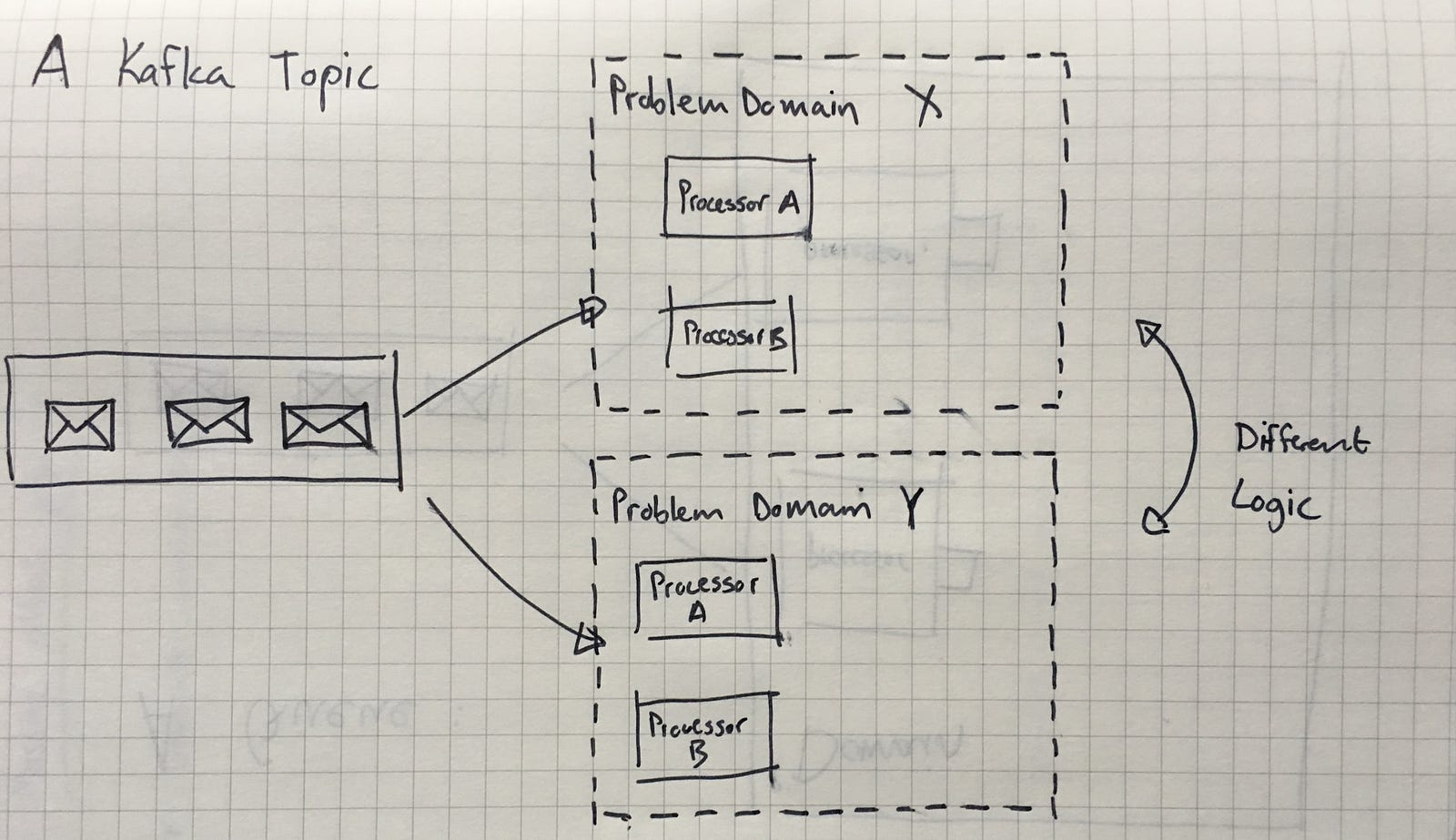快速比较 Kafka 与 Message Queue 的区别
https://hackernoon.com/a-super-quick-comparison-between-kafka-and-message-queues-e69742d855a8
A super quick comparison between Kafka and Message Queues

This article’s aim is to give you a very quick overview of how Kafka relates to queues, and why you would consider using it instead.
Kafka is a piece of technology originally developed by the folks at Linkedin. In a nutshell, it’s sort of like a message queueing system with a few twists that enable it to support pub/sub, scaling out over many servers, and replaying of messages.
These are all concerns when you want to adopt a reactive programming style over an imperative programming style.
The difference between imperative programming and reactive programming
Imperative programming is the type of programming we all start out with. Something happens, in other words an event occurs, and your code is notified of that event. For example, a user clicked a button and where you handle the event in your code, you decide what that action should mean to your system. You might save records to a DB, call another service, send an email, or a combination of all of these. The important bit here, is that the event is directly coupled to specific actions taking place.
Reactive programming enables you to respond to events that occur, often in the form of streams. Multiple concerns can subscribe to the same event and let the event have it’s effect in it’s domain, regardless of what happens in other domains. In other words, it allows for loosely coupled code that can easily be extended with more functionality. It’s possible that various big down-stream systems coded in different stacks are affected by an event, or even a whole bunch of serverless functions executing somewhere in the cloud.
From queues to Kafka
To understand what Kafka will bring to your architecture, let’s start by talking about message queues. We’ll start here, because we will talk about it’s limitations and then see how Kafka solves them.
A message queue allows a bunch of subscribers to pull a message, or a batch of messages, from the end of the queue. Queues usually allow for some level of transaction when pulling a message off, to ensure that the desired action was executed, before the message gets removed.
Not all queueing systems have the same functionality, but once a message has been processed, it gets removed from the queue. If you think about it, it’s very similar to imperative programming, something happened, and the originating system decided that a certain action should occur in a downstream system.
Even though you can scale out with multiple consumers on the queue, they will all contain the same functionality, and this is done just to handle load and process messages in parallel, in other words, it doesn’t allow you to kick off multiple independent actions based on the same event. All the processors of of the queue messages will execute the same type of logic in the same domain. This means that the messages in the queue are actually commands, which is suited towards imperative programming, and not an event, which is suited towards reactive programming.

With queues, you generally execute the same logic in the same domain for every message on the queue
With Kafka on the other hand, you publish messages/events to topics, and they get persisted. They don’t get removed when consumers receive them. This allows you to replay messages, but more importantly, it allows a multitude of consumers to process logic based on the same messages/events.
You can still scale out to get parallel processing in the same domain, but more importantly, you can add different types of consumers that execute different logic based on the same event. In other words, with Kafka, you can adopt a reactive pub/sub architecture.

Different logic can be executed by different systems based on the same events
This is possible with Kafka due to the fact that messages are retained and the concept of consumer groups. Consumer groups in Kafka identify themselves to Kafka when they ask for messages on a topic. Kafka will record which messages (offset) were delivered to which consumer group, so that it doesn’t serve it up again. Actually, it is a bit more complex than that, because you have a bunch of configuration options available to control this, but we don’t need to explore the options fully just to understand Kafka at a high level.
Summary
There is a bunch more to Kafka, for example how it manages scaling out (partitions), configuration options for reliable messaging, etc. But my hope is that this article was good enough to let you understand why you would consider adopting Kafka over good ‘ol message queues.
快速比较 Kafka 与 Message Queue 的区别的更多相关文章
- 为什么要用Message Queue
摘录自博客:http://dataunion.org/9307.html?utm_source=tuicool&utm_medium=referral 为什么要用Message Queue 解 ...
- Message Queue的使用目的
为什么要用Message Queue 摘录自博客:http://dataunion.org/9307.html?utm_source=tuicool&utm_medium=referral ...
- 【转】快速理解Kafka分布式消息队列框架
from:http://blog.csdn.net/colorant/article/details/12081909 快速理解Kafka分布式消息队列框架 标签: kafkamessage que ...
- 消息队列(Message Queue)基本概念(转)
背景 之前做日志收集模块时,用到flume.另外也有的方案,集成kafaka来提升系统可扩展性,其中涉及到消息队列当时自己并不清楚为什么要使用消息队列.而在我自己提出的原始日志采集方案中不适用消息队列 ...
- Top 10 Uses For A Message Queue
We’ve been working with, building, and evangelising message queues for the last year, and it’s no se ...
- MSMQ(Microsoft Message Queue)
http://www.cnblogs.com/sk-net/archive/2011/11/25/2232341.html 利用 MSMQ(Microsoft Message Queue),应用程序开 ...
- 快速理解Kafka分布式消息队列框架
作者:刘旭晖 Raymond 转载请注明出处 Email:colorant at 163.com BLOG:http://blog.csdn.net/colorant/ ==是什么 == 简单的说,K ...
- [转载] 快速理解Kafka分布式消息队列框架
转载自http://blog.csdn.net/xiaolang85/article/details/18048631 ==是什么 == 简单的说,Kafka是由Linkedin开发的一个分布式的消息 ...
- 消息队列(Message Queue)简介及其使用
消息队列(Message Queue)简介及其使用 摘要:利用 MSMQ(Microsoft Message Queue),应用程序开发人员可以通过发送和接收消息方便地与应用程序进行快速可靠的通信.消 ...
随机推荐
- 从Scratch到Python:会动的小猫
大部分人提起儿童编程,就会想到Scratch,然而当儿童升入中学,学习什么语言比较合适呢?我认为,Python是未来的方向,为此我将会把一些经典的Scratch案例用Python重新实现,抛砖引玉,希 ...
- golang Mysql -- Tx
Transaction 事务 事务处理是数据的重要特性.尤其是对于一些支付系统,事务保证性对业务逻辑会有重要影响.golang的mysql驱动也封装好了事务相关的操作.我们已经学习了db的Query和 ...
- 区块链 编译android geth 填坑记录 ubuntu
下载geth 源码 直接 make android 下载android ndk sdk 配置环境变量cd 安装golang 设置环境变量 发现没有gomobile命令 按照wiki方法 执行安装g ...
- webpack学习笔记 (二) html-webpack-plugin使用
这个插件的两个作用: 为html文件中引入的外部资源如script.link动态添加每次compile后的hash,防止引用缓存的外部文件问题 可以生成创建html入口文件,比如单页面可以生成一个ht ...
- wordpress-基础插件,常用函数
一,插件制作 1.首先在plugin文件夹下创建一个php文件,我以制作一个banner插件为例,把以下代码拷贝到php文件中 <?php add_action("init" ...
- C#防盗链处理类的代码
如下的内容是关于C#防盗链处理类的内容. public class FileHandler:IHttpHandler{public FileHandler(){} public void Proces ...
- RxJava2
原文地址 这可能是最好的RxJava 2.x 入门教程(一) 这可能是最好的RxJava 2.x 入门教程(二) 这可能是最好的RxJava 2.x 入门教程(三) 这可能是最好的RxJava 2.x ...
- Monkey工具
Android自动化测试方法,对其中的一些工具.方法和框架做了一些简单的整理,其中包括android测试框架.CTS.Monkey. Monkeyrunner.benchmark.其它test too ...
- centos 7 安装二进制mysql 详细步骤
1 下载地址:https://cdn.mysql.com//Downloads/MySQL-5.7/mysql-5.7.24-linux-glibc2.12-x86_64.tar.gz 复制这个链接在 ...
- UnicodeEncodeError: 'gbk' codec can't encode character '\xbb' in position 30633: illegal multibyte sequence
import urllib.request def load_baidu(): url = "https://www.baidu.com/" header = {"Use ...
